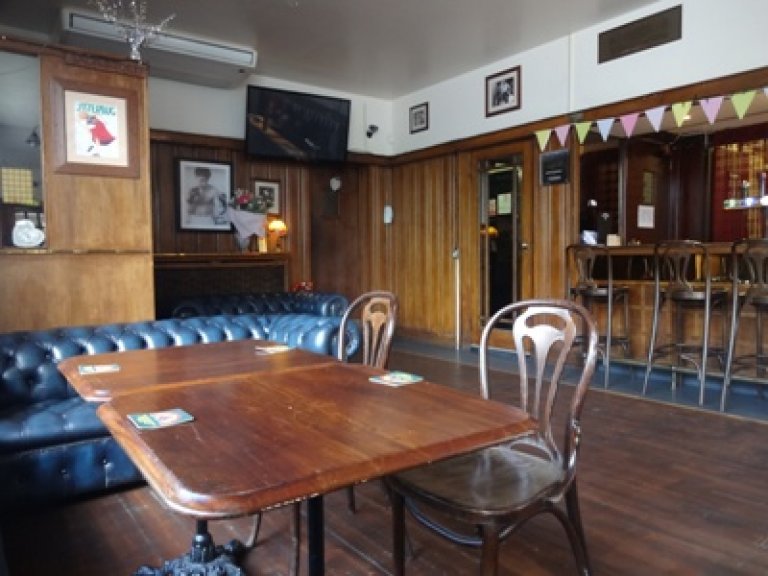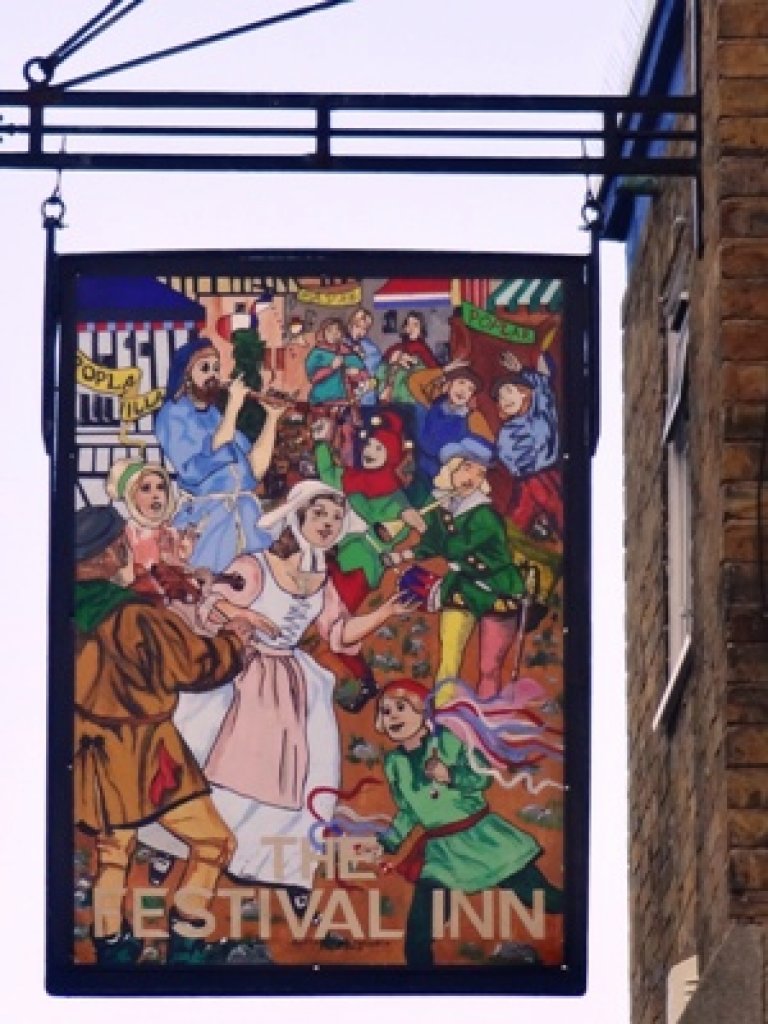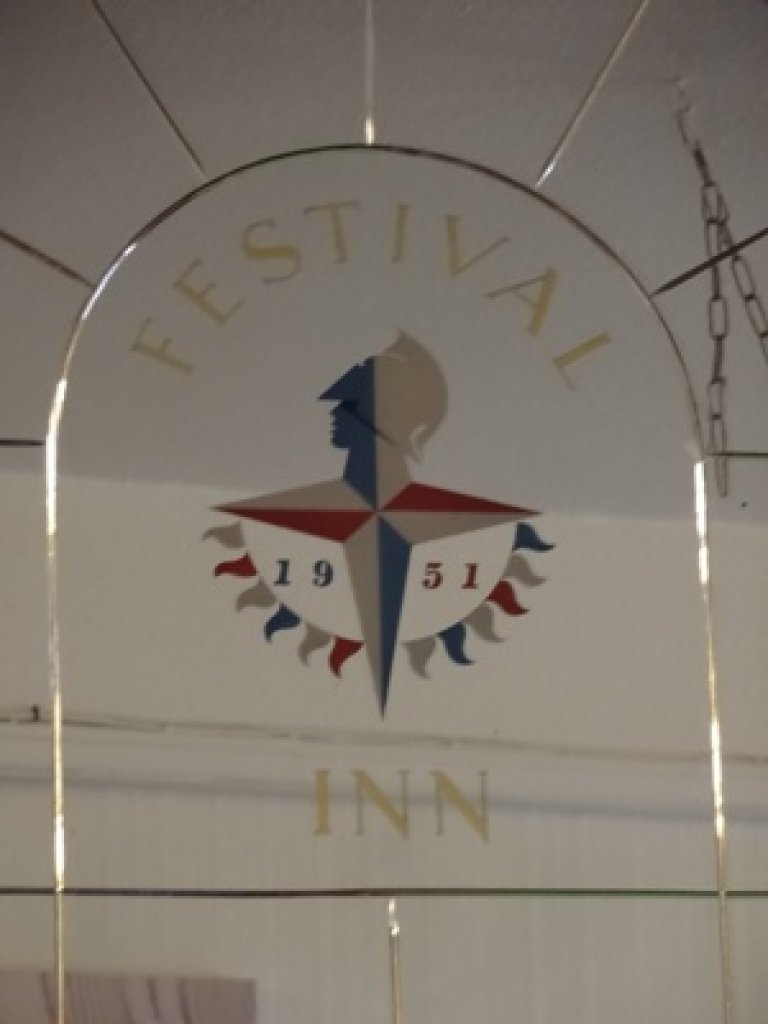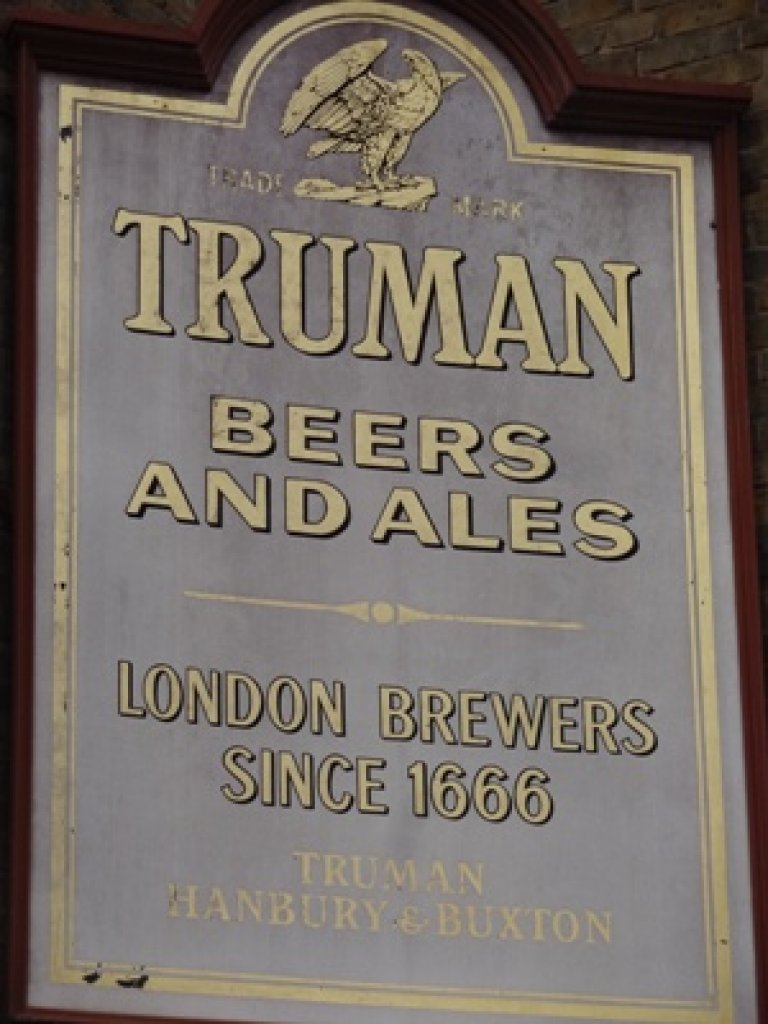Festival Inn
71 Grundy StreetPoplar
E14 6AD
This pub is not only a grade II listed building, it is also a Three Star pub on the Campaign for Real Ale’s (CAMRA) National Inventory with an interior of outstanding national historic importance, and the description is as follows: "A very rare and intact post-war pub, built in 1951/52, built before new pub-building got going again after the Second World War. It takes its name from the Festival of Britain held in 1951 as a British pick-me-up in an austerity-ridden country. It still has its separate public and saloon bars and even the off-sales remains intact (but disused). It is situated at the rear entrance to the Chrisp Street Market, the first purpose-built UK pedestrian shopping area which features a prominent clock tower, shops, small retail outlets, cafes, 80 market stalls and apartments. It was designed by Frederick Gibberd, architcet of the RC cathedral in Liverpool and Harlow New Town. The development forms part of the Lansbury Estate which in 1948 was chosen as the site of the ‘Live Architecture’ Exhibition of the 1951 Festival of Britain. In 1997 Chrisp Street Market was made a Conservation Area – see http://moderngov.towerhamlets.gov.uk/mgConvert2PDF.aspx?ID=7768 which, sadly, does not mention the Festival Inn.
It is a three-storey building of yellow stock brick with a flat-roofed single-storey section on the Grundy Street side faced with tiles (now painted cream), the rear section of the building being part of the shops. The pub was built for Trumans (Black Eagle) Brewery and on both the south and north faces are (white painted) plaster roundels of Trumans' eagle. The front inn sign has a festival scene on the south face and the symbol of the Festival of Britain on the north. By the public bar entrance is a faded simple ‘The Festival Inn Trumans Ales’ inn sign. The exterior windows appear to be original Crittall ones.
The saloon bar, situated on the Grundy Street side with half of it in the flat-roofed part of the building, has a wooden floor. The plan as published in 'The Builder' for August 1951 and shows a tiny partition that linked the bar counter to the fireplace; otherwise it is intact. The bar counter has a front of three sections – on the left and right it is made of wood with grid pattern parquetry and along the top part is a brass panel – the central section is of 1950s style vertical panels. The bar top has a protruding section in the middle which houses a lift used to transport crates from the cellar and to return empties (no longer in use). The back fitting is mirrored with glass shelves. There is a dumb waiter to the first floor. Look for the attractive door to the left of the counter giving access for the bar staff and to the private quarters - it is very much of its time with its large glass panel surrounded by narrow panels in a geometric design.
On the walls are various types of panelling to two-thirds height on both sides of the servery. There is an alcove on the right with a large radiator. Note also the fixed seating (recently reupholstered) with triangular wooden and brass divisions topped by large cylindrical pillars. There are two entrances to the saloon – a corner one on the right and on the left a vestibule with glazed partition on the bar side with the ladies’ toilet leading off to the rear. There is a chimney piece rising from the centre of the saloon bar (but no fireplace now). Toilets modernised.
There is a separate entrance to the public bar. This has a linoleum floor, another bar counter of wood with parquetry in a grid pattern and along the top part is a brass panel: mirrored bar-back fitting with glass shelves. There is an office shown in plan displayed on the right-hand side of the servery. There is much wood panelling Above the fireplace is a mirror with the 1951 Festival of Britain symbol. Toilets modernised.
There is a (disused) door to the left of that to the public bar one to the former off-sales. It retains its counter, back fitting, glazed display case and has the figure ‘3’ above the inside of the front door. At quiet times it is possible for staff to show you the off-sales from within the servery.
The listing description is as follows: The Festival Inn was built as part of Chrisp Street Market, a pedestrianised shopping precinct and open-air market place, designed in 1949 by Frederick Gibberd as the commercial centre of the Lansbury estate and a key element of the Live Architecture Exhibition held as part of the Festival of Britain. Gibberd was responsible for the design of the pub's exterior, while R W Stoddart, the in-house brewery architect, designed the interior. The brewery was Truman, Hanbury, Buxton & Co Ltd.
The Festival of Britain was a nationwide celebration of British arts, industry and technology, held over the summer of 1951. It was a celebration of British achievement, marking the centenary of the Great Exhibition and aiming to engender a sense of national pride and optimism for the country’s post-war recovery. Proposals for an Exhibition of Architecture as part of the Festival had been approved in mid-1948, but it was Gibberd who suggested that it should be ‘live’. He proposed that a bombed, or pre-cleared, site in London should be developed so as to exhibit a real piece of city under renewal. It should illustrate a range of housing and building types as a full-size exhibition of architecture and planning, to be completed for occupation at the end of the Festival.
‘Neighbourhood 9’, within Stepney and Poplar, the largest of the London County Council redevelopment areas, was identified as a suitable site. The neighbourhood was subsequently renamed Lansbury after George Lansbury (1859-1940), former Mayor of Poplar and leader of the Labour Party between 1931 and 1935. A block plan showing heights and massing was prepared by the London County Council (LCC) Architect’s Department, but the design of individual buildings, including schools, churches and housing, was mainly undertaken by private architects. The shopping centre was to be Gibberd’s contribution. Sited in the location of a former street market, Gibberd’s scheme included 38 shops with maisonettes and flats above, garages, a covered market, two pubs and a clock tower, arranged around an open market place.
The Festival Inn, one of Gibberd’s two new pubs, was originally to be named the Grundy Arms, after an earlier pub in the area; a later incarnation of the name was The Festival Arms, before The Festival Inn was finally selected. It was expected that the pub would cater to a large lunch-time trade – buyers and sellers using the market, local residents, ‘business executives’ and of course, the Festival of Britain visitors. Construction work began on 1 May 1950 and the pub’s exterior was completed shortly before Christmas 1950, a moment celebrated with the flying of flags and the hoisting of an ale garland. The interiors were finished by the end of March 1951. There was originally a freestanding pub sign which was by the entrance to the public bar, however this has been lost. Designed by Stoddart, it had the Festival symbol of light, the Skylon, at its centre, while at the top was a circle of dancing figures, representing the everyday Londoner. The construction of new pubs following the Second World War was severely limited by building restrictions which were not lifted until 1954. The Festival Inn was the first complete, permanent pub of the post-war period built to a modern design.
Details Public house, built in 1950-51 to designs by Frederick Gibberd, with interior by R W Stoddart.
MATERIALS: the building is of yellow stock brick, with panels of render, matching the materials of the Chrisp Street Market shopping parades. Much of the ground floor is clad in quartzite tiles, but these have now been painted over. Doors are generally timber, as are ground floor windows, which are divided by unmoulded mullions and transoms. Windows in the upper floors were steel, but have replacements, possibly of aluminium, which replicate the original glazing pattern.
PLAN: the building is on the west edge of the Chrisp Street Market site; roughly orientated north/south, its principal elevations face south onto Grundy Street and west onto Kerbey Street. To the east, the building is attached to the terrace of shops and maisonettes which frame the west side of Chrisp Street Market.
The pub’s footprint is irregular, with back-to-back bar serveries (running north to south) sandwiched between a long narrow saloon bar to the west, and a wedge-shaped public bar to the east. The principal entrances are to the south, facing Grundy Street, where the footprint steps back west to east, with the original off-sales between the entrances to the two bars.
EXTERIOR: the pub’s main block is three storeys in height, with a projecting single-storey section to the west, facing Kerbey Street, which wraps round to the south, facing Grundy Street. This block is clad in over-painted quartzite tiles. At ground floor the west elevation has a broad run of windows which light the saloon bar. The upper part is faced in yellow stock bricks and in the centre is an external chimney stack. The saloon bar can be accessed from double doors on the left of this elevation as well as from the double doors on the Grundy Street elevation.
The single-storey block and yellow facing bricks of the Kerbey Street elevation return onto Grundy Street elevation to the south. The centre of this elevation is rendered, and the ground floor is also faced in quartzite tiles. As well as the entrance into the saloon bar there are a further two doorways – one, at the centre of the elevation, originally serving the off-sales department (now disused and the sales window boarded over), and the other, on the right, leading to the public bar. Over the door to the off-sales is a roundel bearing the Truman’s eagle, and to the left is applied lettering spelling the name of the pub. It is not clear if the lettering is original, but if not, it replaces near identical signage visible in early photographs of the building.
INTERIOR: the interior is simply arranged and finished, but with much of Stoddart’s original scheme intact. His aim was to make the interior of no particular ‘period’ in style, but to make it cheerful and contemporary without being stark. Comparison with Stoddart’s drawings and a photograph published in 1951 show that the public bar (to the east) survives almost completely intact. It is long and narrow, with a counter on the west, set beneath a section of lowered ceiling, containing down-lights and supported by a single column at the north end. A decorative grille in the face of this lowered section of ceiling has gone – either removed or covered over. Beyond the end of the bar counter the space is lit by a domed roof light. At the far north end of the space are entrances to toilets, and between them is a panelled recess containing a dart board, an original feature of the pub as planned. Such darts recesses became a frequent inclusion in pubs built after the Second World War. The panelling and woodwork is original: the counter retains its front of vertical grooved timber and its bar back, the toilet doors have horizontal panels, and the remaining panelling is fielded, rising to dado height. The decorative radiator grilles are also original and are visible in early photos. The simple brick fireplace in the east wall has been boarded over and may survive behind. Originally, the area above this fireplace featured a mural depicting the nearby docks; the mirror in this position today, with the Festival of Britain insignia and the date 1951, was originally over one of the fireplaces in the saloon bar.
The servery is at the centre of the pub, dividing the public and saloon bar areas, as had been typical in pub planning for some time. Opening off its south end is a small off-sales department, given its own short stretch of counter and with a doorway leading from Grundy Street. Off-sales trading ceased around the 1970s – by that time, alcohol could be widely purchased from other outlets, such as supermarkets. Here the off-sales department survives, with its counter, back fitting and glazed display case to one side of the door (covered over on the exterior of the building).
On the west side of the pub, filling the single-storey block, is the saloon bar. This originally comprised two separate but connected areas – one to the north of the central chimney stack, one to the south, but both named ‘saloon bar’ on the architect’s plan. Simple brick fireplaces served both saloon bar areas, and each had their own stretch of the bar, now forming a long single counter on the east side of the space. The space between the bar counter and the east side of the stack was filled with a glazed partition, with an inset bench to the south, and the space on the west side of the stack was completely open, connecting the two spaces. The chimneystack dividing the two bars was partially removed around the 1990s, meaning the loss of the fireplaces and opening up the saloon more as a single large room, but the east part of the stack structure remains, marking the position of this division.
Decoratively, the saloon bar is only slightly more sophisticated than the public bar, a fact which presages the growing consistency of finish in pub bars in the post-war years, and the narrowing social divide. The oak panelling is carried up to frieze (rather than dado) height and the panelling has vertical channels and matches that on the counter-front of the public bar. There is a further section of this panelling on the saloon bar’s counter-front, marking the original division between the two saloon rooms and the termination of the counters; this was originally full height but has been cut down to counter level to create a continuous bar. To either side, the two saloon bar counters survive; these have fronts of contrasting coloured timber formed into an unusual chequer-work motif. The band of brass beneath the projecting countertop seems to be a modern insertion, but on the basis of Stoddart’s original drawing of the room and early photographs, it replaces a similar feature. Along the west wall is a row of structural columns, the lower parts of which are enclosed by fixed bench seating beneath the windows. This seating, and another bench in the south-east corner, is original but has been re-upholstered. At the north end of the saloon bar area, matching those of the public bar, are toilets, in this case with flush-panel doors and some early signage; the door to the ‘ladies’ (to the west) is enclosed by a later internal porch serving the saloon bar door onto Kerbey Street. Radiator grilles match those in the public bar, and the grilles over the bar counter, as with the public bar, have been removed or covered.
The now private stair hall to the north of the servery has dado-height panelling of the same style as the saloon bar. This was originally used by customers (hence its decorative finish) to reach a dining room/club room on the first floor, which had a kitchen adjacent to it. An external staircase at the rear (north) of the pub, opening off the service yard, provided access to the manager’s accommodation on the pub’s second floor. The upper floors and back rooms were not inspected."
The WhatPub entry is here: WhatPub/Festival Inn
The Pub Heritage Group link is here: PHG/Festival Inn
The Festival Inn featured on the Going to the Dogs: Daytime Crawl of the Isle of Dogs, Poplar, Limehouse and Stepney on 17 October 2015.






